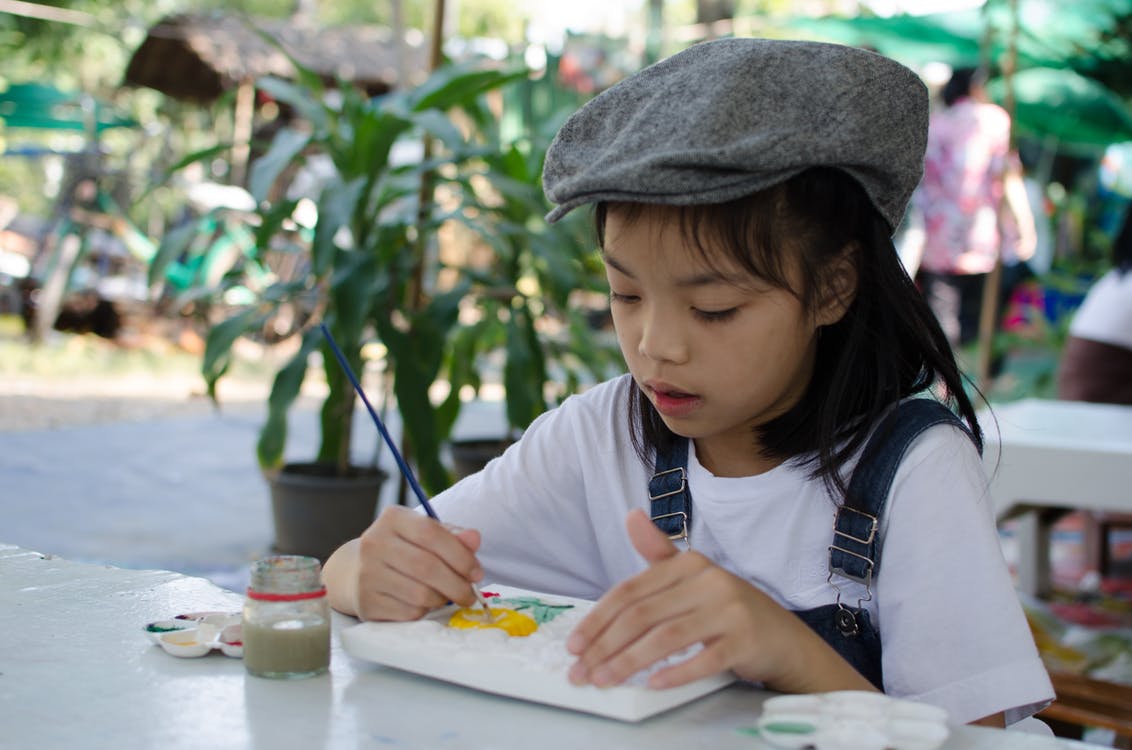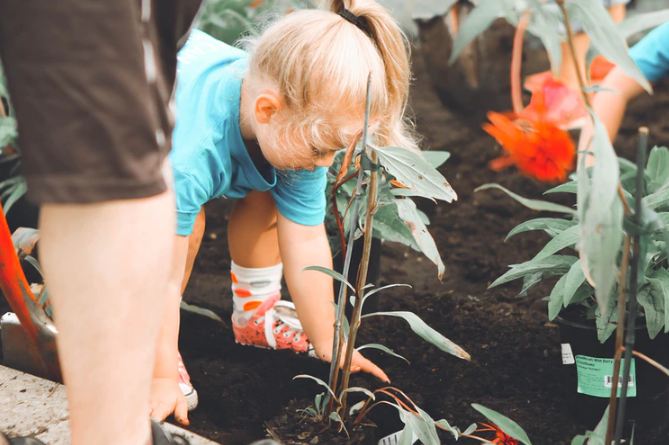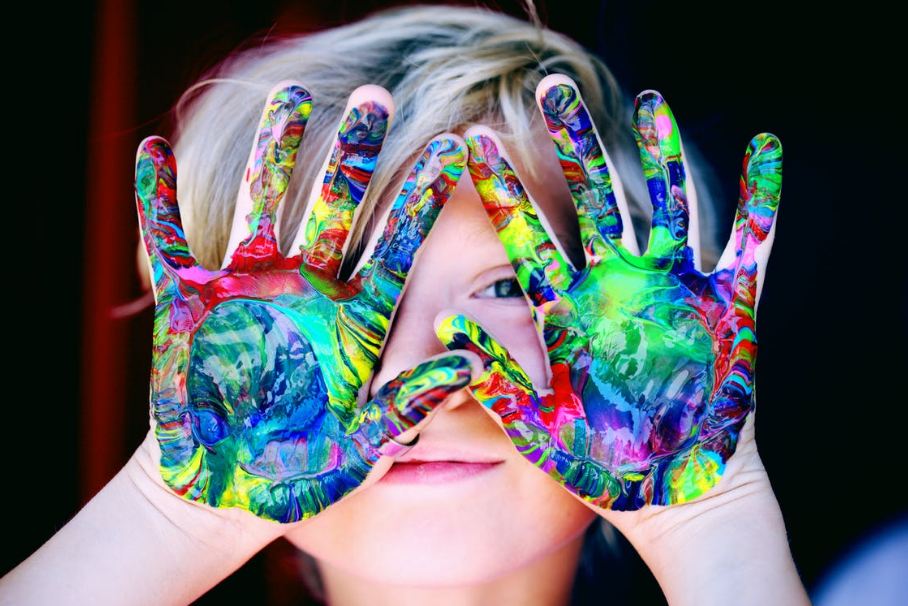How to Host a Virtual Painting Class for Kids
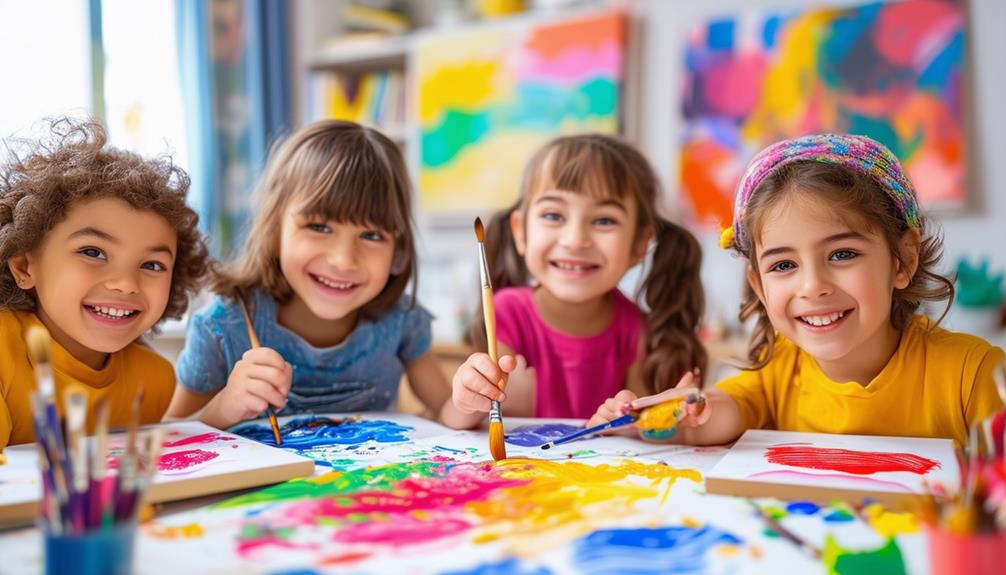
To host a successful virtual painting class for kids, begin by selecting artwork that is vibrant and simple, ensuring it captures their attention without overwhelming them. Schedule the class at a convenient time for most participants and choose a secure, child-friendly platform. Gather necessary supplies such as paints, brushes, and paper, and set up individual painting stations to maintain organization. To keep young artists engaged and make the session memorable, employ strategies that ensure everyone has fun throughout the class.
Selecting the Artwork
When selecting artwork for your virtual painting class, prioritize kid-friendly designs that feature simple patterns and vibrant colors. Start by browsing a catalog of paintings suitable for young artists to ensure the designs are engaging and manageable for children. Colorful, easy-to-follow designs spark creativity and keep kids interested throughout the session.
To further refine your selection, consult rankings and reviews from other customers. These insights can help you choose a design that has been popular with other children. Additionally, detailed video tutorials led by an art instructor are invaluable. These step-by-step guides enable kids to follow along and create their masterpieces with confidence.
Once you've chosen the perfect painting, consider ordering an art materials kit to ensure your kids have everything they need. Kits like the Studio or Basic Kit typically include canvases, brushes, paints, and other essential items. This convenience streamlines the preparation process, allowing you to focus on the enjoyment and creativity of the virtual painting class.
Choosing Date and Platform
Selecting the ideal date and virtual platform is crucial for a seamless and enjoyable painting experience for all the kids involved. Start by choosing a date that aligns well with the kids' schedules, considering their school timings, extracurricular activities, and family routines to maximize participation. Weekends or late afternoons often work best.
For a child-friendly virtual platform, options like Zoom, Google Meet, or Skype are excellent choices. These platforms are user-friendly and widely used, making it simple for kids to navigate. Consider the group's age: younger kids might need more straightforward interfaces, while older kids can handle more features.
Ensure the platform supports interactive elements like screen sharing, whiteboard tools, and chat options. These features enhance engagement and provide immediate feedback and support. Additionally, prioritize a secure environment to protect the kids' privacy and ensure a stress-free session.
Here's a brief checklist to streamline your planning:
- Select a date that aligns with the kids' availability.
- Pick a child-friendly virtual platform such as Zoom, Google Meet, or Skype.
- Ensure interactive elements and a secure setting.
Gathering Supplies
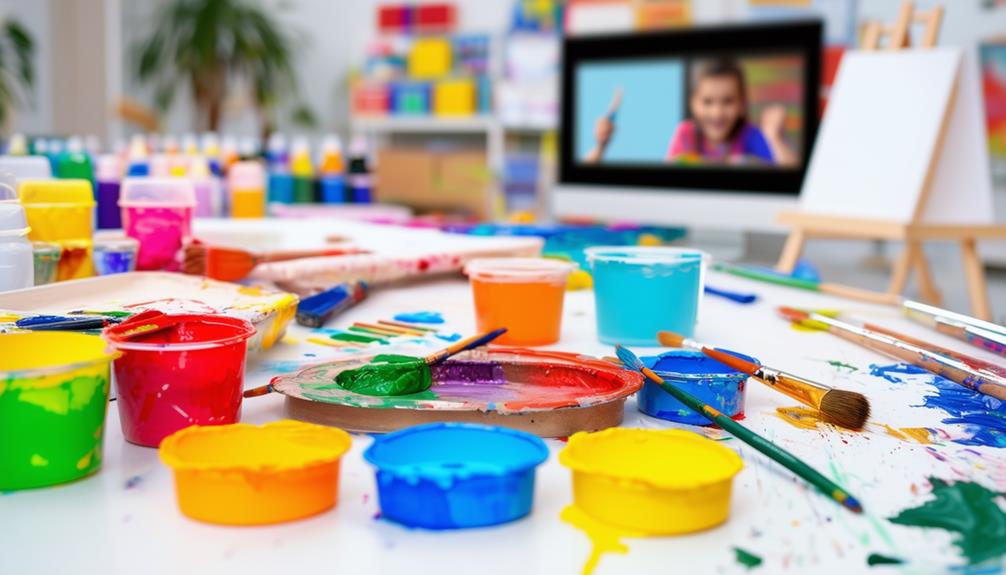
To ensure a smooth and enjoyable virtual painting class for kids, gather all necessary supplies in advance. Start by acquiring washable paints, brushes, paper, easels, and smocks. These items are essential for minimizing mess and ensuring safety. Consider investing in pre-packaged painting kits designed specifically for kids. These kits simplify the process by providing all necessary materials in one package, making your virtual Paint and Sip session more convenient.
Opt for non-toxic, water-based acrylic paint for easy cleanup and safety during the class. These paints are ideal for children and help keep the mess manageable. Encourage creativity by including a variety of colors, brush sizes, and painting surfaces. This variety caters to different preferences and skill levels, ensuring every child can fully enjoy and express themselves.
Don't forget additional supplies like water cups and paper towels for rinsing brushes and cleaning up spills quickly. Also, prepare protective coverings for the painting area to protect furniture and floors. With everything organized, you'll create a fun and engaging atmosphere for your virtual painting class, allowing the kids to focus on their creative expressions.
Prepping in Advance
To prepare, gather all necessary supplies such as paints, brushes, and paper, and assemble individual art kits for each child. Set up a workspace with plastic table covers or newspaper to maintain cleanliness. Include simple instructions and reference images to guide the kids during the class.
Gather Necessary Supplies
Before your virtual painting class for kids begins, ensure you have gathered and organized all necessary supplies. This preparation will help the session run smoothly and keep the kids focused on their creativity rather than searching for materials. A well-prepared setup guarantees a more enjoyable experience for everyone involved.
First, gather the required supplies:
- Paints and Brushes: Have a variety of colors and brush sizes to cater to different artistic expressions.
- Protective Table Covering: Use a disposable canvas wrap or plastic tablecloth to protect surfaces from paint spills. This simplifies cleanup since you can easily dispose of it after the class.
- Water Cups and Paper Towels: Prepare cups of water for rinsing brushes and have paper towels on hand to keep the painting area clean and organized.
Supervising younger children closely during the painting process minimizes spill risks. The protective table covering is particularly helpful because it eliminates the need for extensive cleanup, making it a convenient choice for a virtual painting class with kids. By having these supplies in place, you're setting the stage for a successful and enjoyable creative session.
Set Up Workspace
When setting up the workspace for your virtual painting class, ensure each child has a designated station equipped with easels, brushes, paints, and water cups. This ensures everyone has the necessary tools for a smooth and creative experience.
Start by laying down protective coverings or tablecloths on tables or floors to minimize mess and simplify cleanup. Provide each child with paper towels or rags to clean brushes and manage any spills quickly.
Next, establish a designated teaching area with a camera that provides a clear view of your demonstrations. This setup helps children follow along and understand the techniques being shown. Ensure your workspace is well-lit for visibility.
To create an engaging atmosphere, decorate the workspace with colorful and inspiring elements, such as banners, posters, or your own artwork. An inviting workspace can spark creativity and make the virtual painting class enjoyable for all participants.
Setting Up the Painting Zone
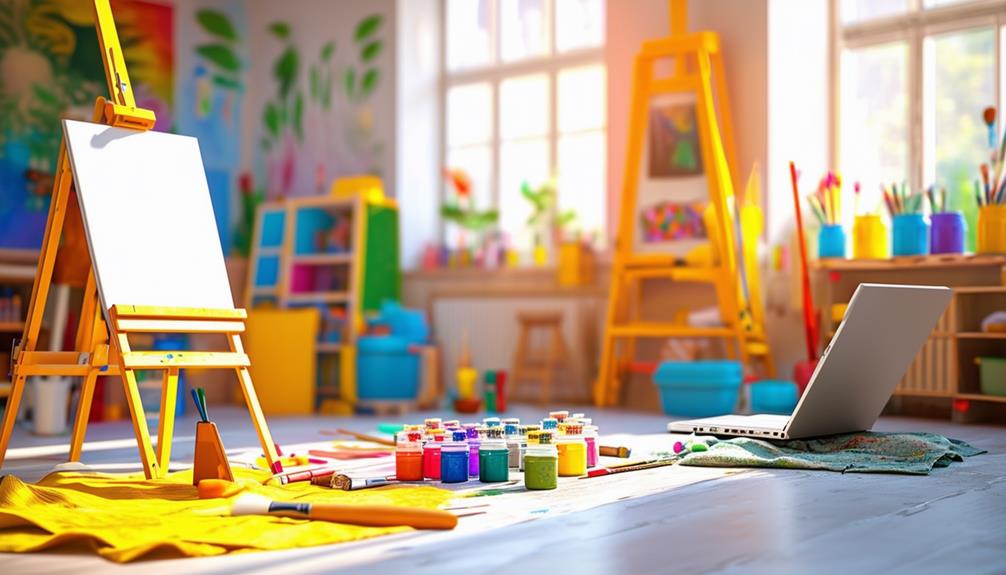
To set up the painting zone, start by organizing materials efficiently so each child has their own set of brushes, paints, water cups, and paper towels. Designate specific areas for painting, ensuring surfaces are protected and the space is well-lit. Plan for easy cleanup by providing aprons and setting up a drying area for their artwork.
Organize Materials Efficiently
Designate a specific area, such as the kitchen or dining room, for the painting session to keep things organized and contained. This helps manage any mess and keeps the focus on creativity. Set up individual painting stations for each child, ensuring each station includes an easel, brushes, paints, and water cups. This setup promotes independence and maintains hygiene by preventing the sharing of supplies.
To further enhance organization, create a central teaching zone where you can demonstrate techniques and provide instructions. A large visual aid will make it easier for all participants to follow along.
Here's a quick checklist to help you organize materials efficiently:
- Cover Surfaces: Use tablecloths or newspapers to protect tables from spills and stains.
- Prepare Supplies: Ensure each child has their own set of brushes, paints, and other necessary items.
- Set Up Teaching Zone: Arrange a central area with a visual aid to facilitate clear instructional demonstrations.
Designate Painting Spaces
Creating the ideal painting zone begins with selecting a well-lit, ventilated area to ensure kids remain comfortable and inspired. Bright, natural light and good airflow are crucial for keeping young artists engaged. Next, establish individual painting stations for each child. This setup helps them concentrate on their work without distractions. Each station should be equipped with an easel, canvas, brushes, and paints, fostering creativity while providing personal space for each child.
Ensure you use protective coverings, such as drop cloths or old sheets, to safeguard tables and floors from inevitable spills and splatters. This precaution not only protects your home but also makes the experience more enjoyable for everyone involved.
For an added touch, consider themed decorations. Whether it's a jungle, under-the-sea, or magical fairyland theme, colorful elements can transform an ordinary area into an exciting art studio. These decorations can ignite imagination and excitement, making the painting session feel like a special event. By following these steps, you'll create a fantastic environment that encourages creativity and fun.
Ensure Easy Cleanup
To ensure easy cleanup, follow these steps:
- Protect Surfaces: Lay down drop cloths or plastic covers to safeguard floors and surfaces from paint spills. This preventive measure will save you significant effort later.
- Provide Apparel: Ensure each child wears an apron to keep their clothes paint-free. Aprons add a fun, artistic element that kids usually enjoy.
- Have Supplies Ready: Keep paper towels or wet wipes within arm's reach to handle unforeseen spills and smudges. Additionally, use disposable cups for water to simplify cleanup by eliminating the need to wash paint cups afterward.
Maximizing the Video Tutorial
To maximize the effectiveness of the video tutorial, share the email link with participants well before the virtual painting class. This ensures everyone has ample time to review the content and gather the necessary materials. During the session, utilize the screen-sharing function to display the video tutorial, keeping everyone synchronized and minimizing confusion. Platforms like Zoom offer optimized video playback settings, ensuring smooth and high-quality viewing for all participants.
Leverage technology to enhance the experience. If children are working on different artworks, consider using separate devices to watch the tutorial. This allows each participant to follow along at their own pace. The screen-sharing function also enables you to pause the video and address questions in real-time, facilitating better interaction.
Encouraging interaction is crucial for a successful virtual painting class. Engage with the kids by asking questions and prompting them to share their progress. This not only makes the session more interactive but also boosts their confidence. By effectively utilizing the video tutorial, you create a seamless and enjoyable painting experience for everyone involved.
Personalizing the Event
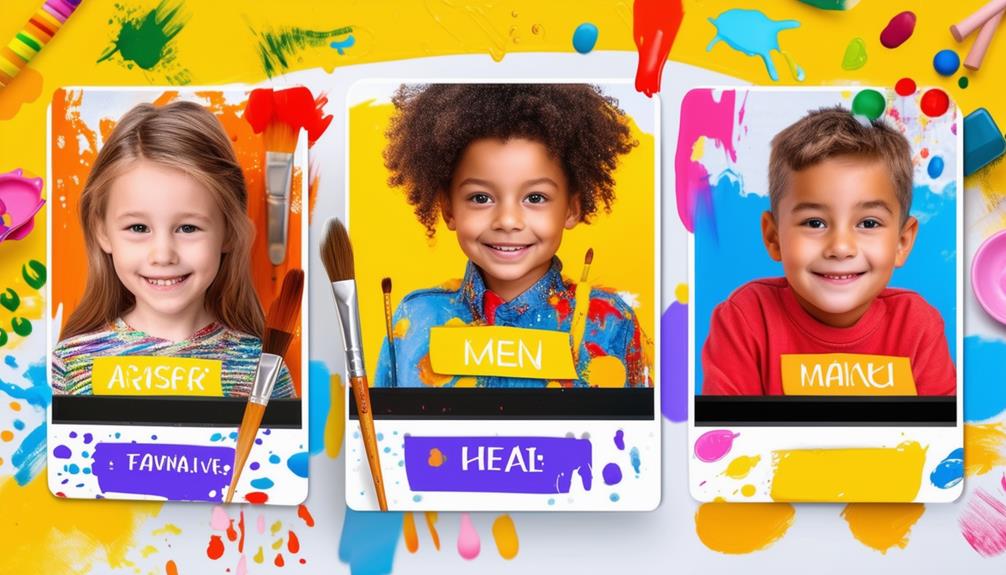
Maximizing the effectiveness of the video tutorial is crucial, but adding personal touches can make the virtual painting class unforgettable for the kids. Personalizing the experience can elevate a standard session to a memorable virtual paint party. Here are some ways to achieve that:
- Themed Decorations and Costumes: Select a fun theme and encourage kids to decorate their painting space or dress up accordingly. Themes like pirates, princesses, or outer space can make the event more engaging and exciting.
- Interactive Games and Activities: Include breaks for paint drying with interactive games or storytelling sessions. These activities entertain the kids and prevent frustration during waiting periods. Pause the tutorial for quick, fun activities to maintain their interest.
- Foster Community and Share Artwork: Create opportunities for kids to share their masterpieces. Start with icebreakers like discussing their favorite colors or talking about their artwork. This fosters a sense of community and connection. Encourage them to share their finished pieces with each other during the class and on social media afterward, giving them a sense of accomplishment.
Personalizing the event with these elements ensures that the virtual painting class is both enjoyable and enriching for the kids.
Encouraging Creativity
Unleashing a child's imagination can transform a basic painting session into an inspiring journey. Begin by offering a variety of vibrant paints and different-sized brushes for kids to experiment with. This assortment of tools will encourage them to explore diverse techniques and textures, giving their art a unique touch.
Introduce themed painting projects to spark their creativity. Themes like animals, nature scenes, or abstract art can provide direction while allowing ample space for personal expression. Offer step-by-step instructions and demonstrations to help them get started, ensuring flexibility so these guidelines serve as a foundation rather than a constraint.
Encourage kids to express themselves freely through their artwork without imposing strict rules. This freedom is critical for fostering creativity. Continually emphasize that there are no mistakes in art, only opportunities to explore new ideas and techniques.
Create a supportive and positive environment where kids feel encouraged to discover their artistic abilities. Praise their efforts and celebrate their unique creations. When children feel supported, they're more likely to take risks and push the boundaries of their creativity, making the painting session not just an activity, but an unforgettable experience.
Sharing Masterpieces
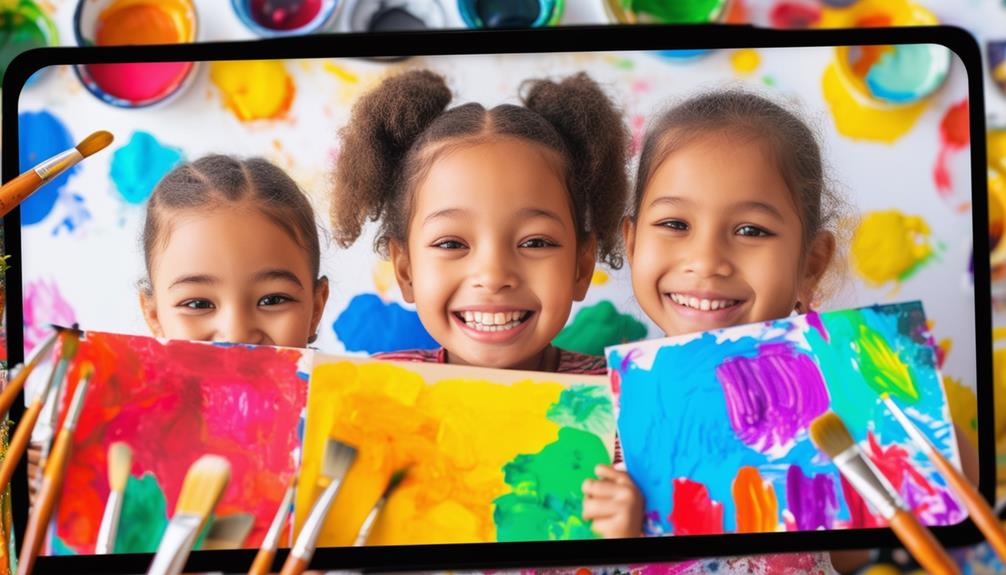
Encourage kids to proudly share their masterpieces during the virtual painting class. This sharing process boosts their confidence and fosters a sense of community. Here are some effective strategies to showcase their creativity:
- Create a Virtual Gallery: Set up an online space where kids can upload photos of their finished artworks, such as a shared folder or a dedicated social media page. A virtual gallery allows everyone to appreciate the diverse masterpieces.
- Host a Show-and-Tell Session: Allocate time at the end of the class for each child to present their artwork. This promotes a positive environment where kids can discuss their inspirations and techniques and receive encouraging feedback.
- Encourage Peer Feedback: Teach kids how to give constructive comments to foster a supportive and positive environment. This helps them learn to appreciate and celebrate each other's paintings genuinely.
Sharing masterpieces in a virtual painting class is about building confidence, community, and a love for creativity. By creating an encouraging space, you help young artists take pride in their work and inspire one another.

